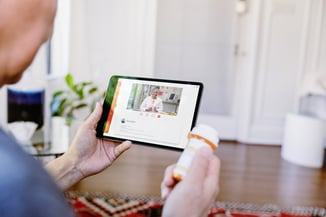
Components of an Omnichannel HCP and Patient Engagement Strategy
The ways that pharmaceutical companies traditionally engage with healthcare providers (HCPs) and patients have been challenged more and more often recently.
 During the COVID-19 pandemic, it was reported that only 34% of HCPs would take an in-person pharma sales meeting. This was a problem before 2020, though - the number of “rep-accessible” HCPs decreased from 80% in 2008 to 44% in 2017 (an HCP is defined as "rep-accessible" if they meet with more than 70% of the sales reps who try to approach them).
During the COVID-19 pandemic, it was reported that only 34% of HCPs would take an in-person pharma sales meeting. This was a problem before 2020, though - the number of “rep-accessible” HCPs decreased from 80% in 2008 to 44% in 2017 (an HCP is defined as "rep-accessible" if they meet with more than 70% of the sales reps who try to approach them).
One of the major reasons for this decline is the digital transformation of healthcare organizations. HCPs turn to digital health for convenience which proved essential during the COVID-19 pandemic.
In addition, the rise of health consumerism over the past decade has ushered in a new approach to care delivery that puts the patient at the center with the health system revolving around their needs. HCPs, more than ever, are provided the opportunity and ability to meet patients where they are.
Patients also want the same convenience and access in healthcare that other industries offer with digital tools.
Since digital is the realm where HCPs and patients are spending much of their time along the healthcare journey, this is where pharma needs to expand and innovate to meet stakeholders. 
This refers to a strategy of proactively placing digital, conversational resources into the hands of HCPs and patients through their preferred channels.
These are the key components of an omnichannel outreach strategy that targets HCPs and patients in their environments at convenient and relevant times along the care journey:
1. Properly identifying and targeting HCPs and patients
To successfully engage targeted HCPs and patients, it is essential to understand and identify specific populations. These populations may be categorized by disease, department, treatment, or other groups. Stratifying targets enables pharma to personalize the content and method of outreach.
Once these cohorts are created, conversational AI enables the experiences to be tailored to each cohort, and even further, each individual.
2. Proactive outreach
Proactive outreach is one of the keys to a “beyond the bot” strategy. Timing is everything, and proactively engaging patients and their care team before treatment begins can minimize risks and improve outcomes.
Examples of proactive messages include medication and appointment reminders, educational tips and resources, as well as direction to tools such as a chatbot.
3. Cascading communication
Many organizations have relied on multichannel outreach to engage stakeholders. This offers individual resources through specific channels. Omnichannel on the other hand prioritizes the patient and meets them where they are by providing access to resources through all available channels, such as SMS, email, and phone.
When creating and deploying an omnichannel outreach campaign, optimal engagement can be achieved by cascading communication from one channel to the next, until the target is successfully engaged.
4. Collecting insights
Data collected through an outreach campaign can improve the user’s experience as well as engagement rates. Understanding how users engage and the optimal channel of engagement improves future campaigns and can better meet that user where they are.
Moving “beyond the bot” will not only build brand loyalty but will also improve patient adherence. These components of an engagement strategy help pharmaceutical companies effectively reach HCPs and patients on the device and modality of their choice.

